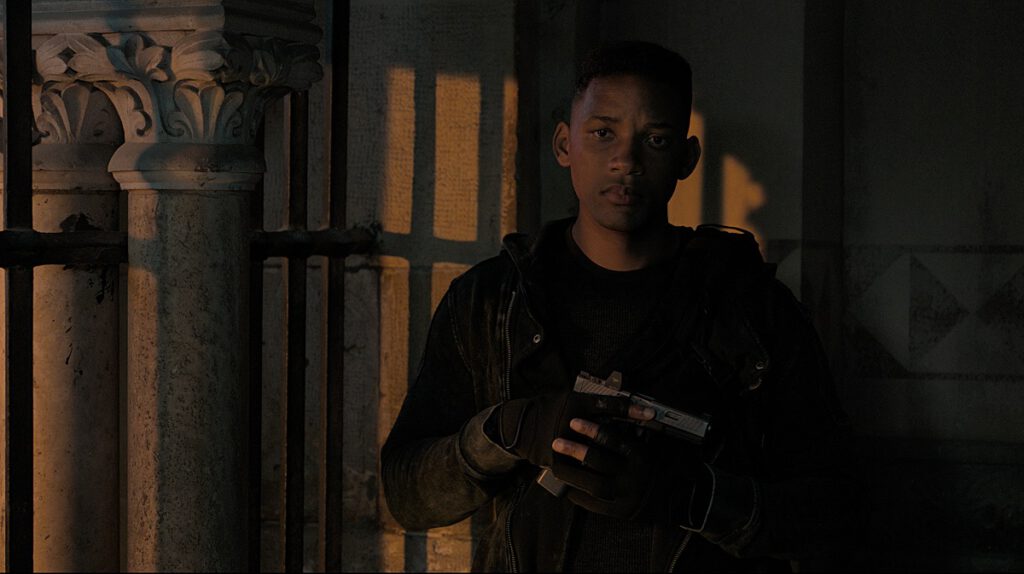By the time newly retired hitman Henry Brogan (Will Smith) first lays eyes on his pursuer and younger clone Junior (a digitally de-aged Will Smith) our own eyes are finally adjusting to the 120 frames-per-second 3D photography of Ang Lee’s “Gemini Man.” But this payoff is inherently meta. Consider a later scene where the two expound on their childhoods. Brogan—the real Will Smith—tells Junior he’s originally from Philadelphia. This remark is meant to draw a laugh from the audience for a couple of reasons: 1) Smith was born in Philadelphia and 2) so was Smith’s title character in the sitcom that launched his career, “The Fresh Prince of Bel-Air.” However, no one else seemed to bask in the irony of watching 51-year-old Will Smith converse with a digitally rendered 25-year-old Will Smith (which is the age Smith was at the height of his Fresh Prince fame). And that’s when it hit me. Many of the viewers in the auditorium weren’t even alive when “The Fresh Prince” made its first run. These younger moviegoers could care less about pop culture footnotes. Instead, their eyes were intensely focused on the screen, not as fanatics but as moving image critics. They were much more interested in sizing up Lee’s 120fps technological experiment and gauging if it passed their seen-it-all litmus test. This is who Lee made this movie for.
That’s why it’s a shame “Gemini Man” was a box office disappointment. As it headed into its opening weekend, “Gemini Man” was doomed to underperform. It was branded with a “Rotten” Tomatometer score—a scarlet letter in the eyes of the public. Plus, #FilmTwitter did its part by dragging the film’s simplistic and predictable plot through the mud. “Gemini Man” quickly became the redheaded stepchild of the fall movie season. It only guarantees that the best platforms to watch it—in the theatre, on a big screen, in 3D—won’t be available much longer.
It’s a shame the youth didn’t turn out in droves for this movie because “Gemini Man,” for all of its elementary plotting and paint-by-numbers performances, is a groundbreaking technological marvel. It is specifically made for Generation Z: a generation of moviegoers who—as CNBC points out—“grew up with the internet, handheld devices and social media. They do not remember a time when these things did not exist.” This younger generation of moviegoers is much more sophisticated when it comes to looking at and processing the moving image. They grew up with smart tablets in their cribs and then beds. For many, mobile video viewing is their primary introduction to understanding the world. And 90% of them will grow up to watch online video on their smartphone on a daily basis. In short, Generation Z is the perfect focus group for Lee. There’s nothing this generation of moviegoers hasn’t already seen on their smartphones or computers since they were infants. They’re the hardest movie critic to win over. They’ve literally seen it all.

In consideration of these eye-opening truths, “Gemini Man” uses fundamental components of Generation Z’s daily visual intake—the immersive quality of a video game coupled with the de-aging filter frenzy of FaceApp—and amps up the image delivery through Lee’s high frame rate shooting style. The results aren’t always successful but there are a good number of action sequences in “Gemini Man” that are truly visual marvels. In particular, there’s an apartment complex shootout that escalates to an exhilarating motorcycle chase through the streets of Cartagena, Colombia. You feel like you’re right there with the characters, with a logic of video game point-of-view but with the visceral thrill of real-life, tangible danger. It’s in these sequences that we are actually seeing a new kind of visual language for movies. “You process HFR 3D differently, you process it like real life,” Lee recently told IndieWire. “Film got so good because for over a hundred years, genius after genius, craftsman after craftsman, years of audience feedback, it got really sophisticated. I just believe there is a very different beauty, a dreamlike-ness in digital. I’m trying to find it.”
Lee is onto something here. He’s not only trying to merge the way new content is delivered (which is mostly digitally nowadays) with how that content is created (also digitally) but is considerate of how younger viewers might not see “cinema” in the same textbook definition—for example, 24 frames per second film stock—as older generations have. Therefore, shooting in a digital high frame rate isn’t so much a denouncement of celluloid as it is an “adapt or die” manifesto to the times. On the indie side, look at something like Slim Cinema, a film festival in New York that only shows videos shot in the vertical format: “Our smartphones have increasingly become extensions of our body and the screen where we spend most of our time. This trend of design vs. behavior comes as no surprise since it caters to the natural human motion when it comes to consuming content since we tend to hold our devices upright vs. sideways.” Cinema is no longer held to formal constraints. Cinema has become less of a model and more of a mutation. It’s changing all the time.

Unfortunately, the word “cinema” has been tied to an archaic anchor in daily online discourse. People think of “cinema” as a term of validity as opposed to an idea that moving image art can draw empathy from a viewer. Because of this misunderstanding, you have fanboys getting upset at Martin Scorsese for saying Marvel movies aren’t cinema. Then you also have theatre owners who say Netflix is destroying moviegoing. If anything, theatre owners should support more risk-taking, technology-pushing event films like “Gemini Man.” At least here they can promise a unique viewing experience and one that can’t be replicated at home. Alas, it all goes back to what cinema is. It’s all of this and soon it will be none of it. Today, cinema is watching “Gemini Man” in a state-of-the-art auditorium with crisp 3D projection and tomorrow cinema is re-watching “Gemini Man” on Hulu while live-tweeting secondary reactions to the silly plotline. It’s all ci-ne-ma!
There is a radical shift happening on the content creation side, how it’s delivered and ultimately how it’s deciphered by the viewer. Sadly, on the film curation and taste-making side, many of the current gatekeepers are still approaching “cinema” from an analog standpoint. If it’s new or unfamiliar, it’s mostly met with apprehension before it’s embraced with any approval. Again, that’s why #FilmTwitter buried “Gemini Man.” It was a stupid move on their part, because let’s be honest—who is going to see “Gemini Man” for its screenplay? The real draw here is Lee’s imagery and technological bravado, the moving image writ large. Fortunately, Lee understands the value of this next generation of younger moviegoers, this next wave of new minds ready to push the envelope. They’ll be the ones to pick up where Lee leaves off. It’s no wonder he’s employing this new cutting-edge technology to make a movie about a man whose younger self is coming to remove him from the picture. How fitting.











